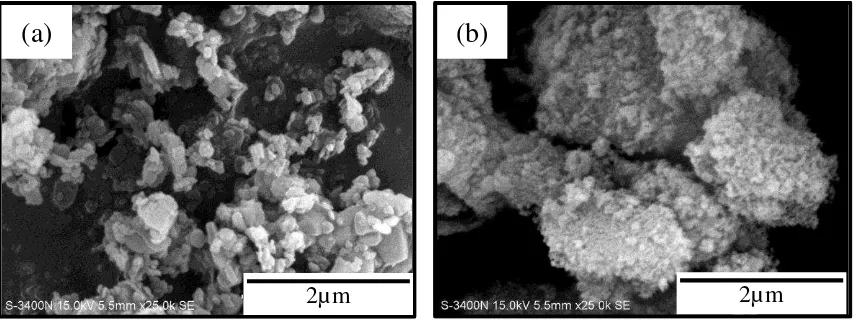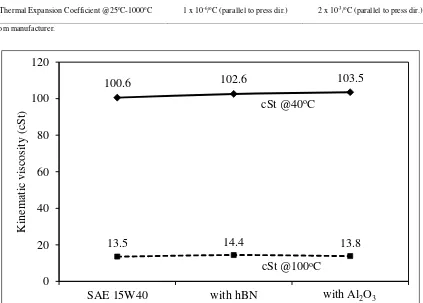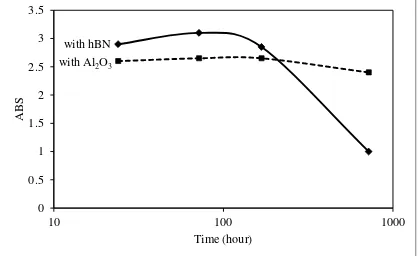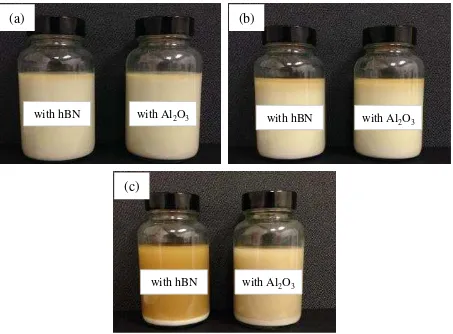2014 Volume (issues) 32(5): 3261-3268
Effect of hBN/Al
2
O
3
nanoparticles on engine
oil properties
Muhammad Ilman Hakimi Chua Abdullah
1,
Mohd Fadzli Bin Abdollah
1,2,, Hilmi Amiruddin
1,2,
Nur Rashid Mat Nuri
2,3, Noreffendy Tamaldin
1,2, Masjuki Hassan
4,
S.A. Rafeq
1,21
Universiti Teknikal Malaysia Melaka, Faculty of Mechanical Engineering, Hang Tuah Jaya, 76100 Durian
Tunggal, Melaka, Malaysia.
2
Universiti Teknikal Malaysia Melaka, Centre for Advanced Research on Energy, Hang Tuah Jaya, 76100 Durian Tunggal, Melaka, Malaysia.
3
Universiti Teknikal Malaysia Melaka, Faculty of Engineering Technology, Hang Tuah Jaya, 76100 Durian Tunggal, Melaka, Malaysia.
4
University of Malaya, Faculty of Engineering, 50603 Kuala Lumpur, Malaysia.
Received: 11 March 2013; accepted: 15 May 2014
Abstract
This paper provides oil properties study of conventional diesel engine oil enriched with hBN/Al2O3 nanoparticles. In this study, an optimal composition (0.5 vol.%) of 70nm hBN and Al2O3 nanoparticles separately dispersed in SAE 15W40 diesel engine oil by sonication technique. The oil properties were studied by measuring the Viscosity Index (VI), Total Acid Number (TAN), Total Base Number (TBN) and flash point temperature. In addition, the stability of nanoparticles in oil was also observed by measuring the absorption value over time using ultraviolet (UV) spectrometer. The results reveal that the nano-oil with hBN nanoparticles could improves or at least maintain the key lubrication properties, though the TAN value is slightly increased. In addition, the dispersion of nano-oil was stable up to 168 hours before the sedimentation occurs. The dispersion of nano-oil with hBN nanoparticles is better than that of nano-oil with Al2O3 nanoparticles. The results presented here may facilitate improvements in the conventional diesel engine oil properties performance.
Keyword:hBN nanoparticles; Al2O3 nanoparticles; Oil properties ©Sila Science. All rights reserved.
Corresponding author. Tel.:+606-234-6805/6914; fax: +606-234-6884.
1. Introduction
Nowadays, there are a great variety of advanced lubrication technologies includes thin film coatings [1-4], nanolubricants [5-6] and gas lubricant [7-8]. The technology involved in lubrication by nanoparticles is a rapidly developing scientific area and one that has been watched with interest for the past ten years. Nanolubrication offers a solution to many problems associated with traditional lubricants. With the increase in the number of vehicles, the problems with fuel consumption and environmental pollution are becoming more prominent. The use of an energy-conserving and emission-reducing automotive engine oil additive would have a great impact on energy conservation and environment protection. However, some additives such as Zinc dialkyldithiophosphates (ZDDP), containing phosphorus and sulfur substance, can poison the catalytic converter which results to the failure of the emission system. Therefore, researchers and scientists are now looking for environmental friendly additives that have an ability to enhance, or at least maintain the key lubrication properties.
Recently, nanoparticles is the most promising additives, where a low concentration of nanoparticles between 0.2% and 3% vol. into lubricating oil is sufficient to improve tribological properties [9-15]. Qiu et al. [14] found that the concentration of Ni nanoparticles between 0.2 and 0.5% provides the best anti-wear behavior and friction reduction. Tao et al. [15] demonstrated that 1% is considered the optimum concentration for the diamond nanoparticles in paraffin oil. In addition, friction-reduction and anti-wear behaviors are dependent on the characteristics of nanoparticles, such as size, shape, and concentration. The size of nanoparticles is mostly in the range of 2 to 120 nm [16-18]. The mechanisms of friction-reduction and anti-wear of nanoparticles in lubricant have been reported as colloidal
effect, rolling effect, protective film, and third body. Chĩas-Castillo and Spikes [19]
investigated the action mechanism of colloidal solid nanoparticles in lubricant oils. Their study showed that in thin film contacts, colloid nanoparticles penetrate elastohydrodynamic (EHD) contacts, mainly by a mechanism of mechanical entrapment.
In general, as observed from prior studies, a lot of studies were investigated on the tribological properties of lubricating oil with addition of nanoparticles. However, there are a limited number of studies to investigate the oil properties of conventional diesel engine oil enriched with nanoparticles. Hence, the goal of this paper is to investigate the oil properties of
conventional diesel engine oil by dispersing hBN/Al2O3 nanoparticles.
The uniqueness of this study exists in the fact that low-cost and environmental friendly
hBN/Al2O3 nanoparticles, dispersed in conventional diesel engine oil, could potentially
enhance the oil properties performance. This promising technology has an even greater impact on fuel consumption and engine durability for a greener future. Besides, good lubrication and thermal conductivity properties, which can simultaneously improve oil properties, performance and boost heat transfer in engines [20], were the key factors for using hBN/
2. Methods
Nano-oil was prepared by dispersing separately an optimal composition (0.5 vol.%) of
70nm hBN and Al2O3 nanoparticles in SAE 15W40 diesel engine oil by sonication technique,
using ultrasonic homogenizer for 20 minutes. Samples were stabilized using a surfactant (oleic acid) to prevent sedimentation of nanoparticles. The optimal composition was
determined from the previous work [6]. The hBN and Al2O3 nanoparticles were observed
using Scanning Electron Microscopy (SEM). The oil properties were investigated in terms of Viscosity Index (VI), Total Acid Number (TAN), Total Base Number (TBN) and flash point
temperature. The VI was calculated from kinematic viscosity at 40oC and 100oC, using a
viscometer, according ASTM D2270-04 standard practice. The TAN, TBN and flash point temperature were measured using 716 DMS Methrohm machine and flash point meter, respectively. Besides, the stability of nano-oil was also observed by measuring the absorption value over time using UV spectrometer in which the conventional diesel engine oil was set as a background.
3. Results and discussions
Figure 1 shows the SEM image of hBN and Al2O3 nanoparticles. As shown in Figure 1(b),
Al2O3 nanoparticles agglomerated. However, the hBN nanoparticles were well dispersed and
their sizes were rather uniform. The physical properties of the nanoparticles are shown in Table 1.
2µm 2µm
(b)
(a)
Fig. 1. SEM micrograph of (a) hBN nanoparticles and (b) Al2O3 nanoparticles.
The kinematic viscosity of nano-oil at 40oC and 100oC is slightly increased, as compared
with conventional diesel engine oil, as shown in Figure 2. From the view point of boundary lubrication, these results may be due to the higher film thickness ratio.
From Figure 3, the finding provides evidence that nano-oil with hBN nanoparticles improves the VI value approximately 3%, as compared with conventional diesel engine oil
and with Al2O3 nanoparticles additives. This circumstance may be due to lower thermal
expansion coefficient of hBN nanoparticles (1 x 10-6/oC), so it has a good effect on thermal
stability properties and directly give a significant impact on the viscosity index characterization.
gradually, as compared with conventional diesel engine oil. Increment approximately 20% for
nano-oil with hBN nanoparticles and 27% for nano-oil with Al2O3 nanoparticles is not
preferable because the TAN value indicates the existence of naphthenic acid corrosion problem. This corrosion might create a failure inside the engine component and can cause hazards emission to the environment.
The higher the TBN, the more effective it is in suspending wear-causing contaminants and reducing the corrosive effects of acids over an extended period of time. Therefore, the higher value of TBN could eliminate the negative effect of the TAN value.
The flash point of lubricant can be defined as lowest temperature at which it can vaporize to
form an ignitable mixture in air. Although the flash point temperature of nano-oil with Al2O3
nanoparticles is slightly decreased, there is no significant difference in flash point temperature between the conventional diesel engine oil and with hBN nanoparticles additives.
Table 1. Physical properties of hBN and Al2O3 nanoparticles
Properties a hBN Al
2O3
Appearance White powder White powder
Average particle size (nm) 70 70
127
VI TAN [mgKOH/g] TBN [mgKOH/g] FP (oC)
SAE 15W40
Fig. 3. The oil properties comparisons between SAE 15W40, with hBN and Al2O3
nanoparticles.
From Figure 4, the higher absorbency indicates that the dispersion of nano-oil with hBN
nanoparticles is better than that of nano-oil with Al2O3 nanoparticles. The dispersion for both
nano-oil was stable up to 168 hours. However, the stability of nano-oil with hBN nanoparticles decreased sharply with the 63% reduction in absorbency value at 720 hours.
The photographs shown in Figure 5 were taken after the nano-oil was kept at room temperature for 24 hours, 72 hours, 168 hours and 720 hours. As can be seen from Figure 5(c), the nano-oil with hBN nanoparticles precipitated more at the bottom of the bottle, which correlates well to a smaller value of absorbency at 720 hours. This phenomena may be due to the adsorption of oleic acid as a surfactant in nano-oil is unable to sustain and not suitable for prolonged stability. Further investigation will be required to address the sedimentation problem of nano-oil.
From the above analyses it is quite evident that the nano-oil with hBN nanoparticles has
better oil properties compared than the nano-oil with Al2O3 nanoparticles.
with hBN with Al2O3 with hBN with Al
2O3
with hBN with Al2O3
(a)
(b)
(c)
Fig. 5. Photograph of oil solution with different nanoparticles after (a) 24 hours, (b) 168 hours and (c) 720 hours.
4. Conclusion
This paper presented results of hBN/Al2O3 nanoparticles as additives for improving
conventional diesel engine oil properties. In summary, as compared with conventional diesel
engine oil with and without Al2O3 nanoparticles, the current study proves that the hBN
is slightly increased. However, the higher value of TBN could eliminate the negative effect of the TAN value, which makes the nano-oil with hBN nanoparticles is much better than the
nano-oil with Al2O3 nanoparticles. Besides, the dispersion of nano-oil was stable up to 168
hours before the sedimentation occurs. The higher absorbency indicates that the dispersion of
nano-oil with hBN nanoparticles is better than that of nano-oil with Al2O3 nanoparticles.
Overall, this study has contributed to our knowledge about the effectiveness of hBN
nanoparticles as compared with Al2O3 nanoparticles for improving oil properties. In particular,
further investigation for addressing sedimentation problem of nano-oil will be necessary and will be taken into consideration for future work.
Acknowledgment
The authors gratefully acknowledge contributions from the members of the Green Tribology and Engine Performance (G-TriboE) research group. This research is supported by
grants from the World Academy of Sciences (TWAS) [grant number:
GLUAR/2013/FKM(2)/A00003], Ministry of Education Malaysia [grant numbers: FRGS /2013/FKM/TK01/02/1/F00163 and FRGS/2013/FTK/TK06/02/3/F00166], and Universiti Teknikal Malaysia Melaka (UTeM) [grants number: PJP/2012/FKM(40A)/S01044 and PJP/2012/FKM(11A)/S01086].
References
[1] Abdollah MFB, Yamaguchi Y, Akao T, Inayoshi N, Miyamoto M, Tokoroyama T, Umehara N. Future developments of a deformation-wear transition map of DLC coating. Tribology Online 2012;3:107-111.
[2] Abdollah MFB, Yamaguchi Y, Akao T, Inayoshi N, Miyamoto M, Tokoroyama T, Umehara N. Deformation-wear transition map of DLC coating under cyclic impact loading. Wear 2012; 274-275:435-441.
[3] Abdollah MFB, Yamaguchi Y, Akao T, Inayoshi N, Miyamoto M, Tokoroyama T, Umehara N. The effect of maximum normal impact load, absorbed energy, and contact impulse, on the impact crater volume/depth of DLC coating. Tribology Online 2011;6:257–264.
[4] Abdollah MFB, Yamaguchi Y, Akao T, Inayoshi N, Miyamoto M, Umehara N, Tokoroyama T. Phase transformation studies on the a-C coating under repetitive impact. Surface and Coatings Technology 2010;205:625-631.
[5] Abdullah MIHC, Abdollah MF, Amiruddin H, Tamaldin, Nuri NRM. Optimization of tribological performance of hBN/Al2O3 nanoparticles as engine oil additives. Procedia Engineering 2013;68:313-319.
[6] Abdullah MIHC, Abdollah MF, Amiruddin H, Tamaldin, Nuri NRM. Optimization of tribological performance of hBN/Al2O3 nanoparticles as engine oil additives. Procedia Engineering 2013;68:313-319.
[8] Abdollah MFB, Mazlan MAA, Amiruddin H, Tamaldin, N. Experimental study on friction and wear behaviors of bearing material under gas lubricated conditions. Jurnal Teknologi (Sciences and Engineering) 2014;66:43-49.
[9] Zhang M, Wang X, Liu W, Fu X. Performance and anti-wear mechanism of Cu nanoparticles as lubricating oil additives. Industrial Lubrication and Tribology 2009; 61:311-318.
[10] Li W, Zheng S, Cao B. Friction and wear properties of ZrO2/SiO2 composite nanoparticles. Journal of Nanoparticle Research 2011;13:2129-2137.
[11] Wu YY, Tsui WC, Liu TC. Experimental analysis of tribological properties of lubricating oils with nanoparticles additives. Wear 2007;262:819-825.
[12] Rapoport L, Leshchinsky V, Lvovsky M, Nepomnyashchy O, Volovik Y, Tenne R. Mechanism of friction of fullerenes. Industrial Lubrication and Tribology 2002;54:171-176.
[13] Hwang Y, Lee C, Choi Y, Cheong S, Kim D, Lee K, Lee J, Hyung Kim S. Effect of the size and morphology of particles dispersed in nano-oil on friction performance between rotating discs. Journal of Mechanical Science and Technology 2011;25:2853-2857.
[14] Qui S, Zhou Z, Dong J, Chen G. Preparation of Ni nanoparticles and evaluation of their tribological performance as potential additives in oils. Journal of Tribology 1999;123:441-443. [15] Tao X, Jiazheng Z, Kang X. The ball-bearing effect of diamond nanoparticles as an oil additive.
J. Phys. D: Appl. Phys. 1996;29:2932.
[16] Chen S, Liu W. Oleic acid capped PbS nanoparticles: Synthesis, characterization and tribological properties, Materials Chemistry and Physics 2006:98:183-189.
[17] Chen S, Liu W, Characteristic and antiwear ability of non-coated ZnS nanoparticles and DDP-coated ZnS nanoparticles, Materials Research Bulletin 2001:36:137-143.
[18] Zhang ZF, Liu WM, Xue QJ. The tribological behaviors of succinimide-modified lanthanum hydroxide nanoparticles blended with zinc dialkyldithiophosphate as additives in liquid paraffin, Wear 2001:248:48-54.
[19] Chĩas-Castillo F, Spikes HA. Mechanism of action of colloidal solid dispersion, Journal of Tribology 2003:125:552-557.



